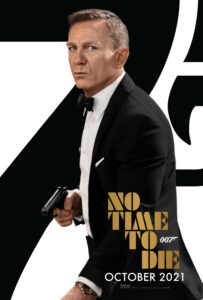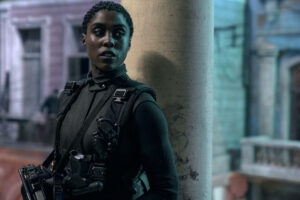Film Review: Daniel Craig Goes Out Fighting in Engaging “No Time to Die”
Written by: Christopher Llewellyn Reed | October 1st, 2021

No Time to Die (Cary Joji Fukunaga, 2021) 3 out of 4 stars.
A nearly lifelong connoisseur of the James Bond universe, I have read all the original Ian Fleming books and have never missed a movie in the series. Over the years, my youthful passion may have waned, allowing me to turn a far more critical eye on the character and his exploits than I once did, yet a definite interest remains. I once taught a university course on Agent 007, since the Eon Productions films, in the hands of the same family today as in the beginning (the 1962 Dr. No), offer a fascinating case study in changing aesthetics, mores, and ideologies. Study them and you emerge with a strong appreciation of our cultural and artistic evolution over nearly 60 years. And though the action and adventure can be appreciated as the entertainment they were always meant to be, there is no question that in the era of Daniel Craig, the Bond franchise has taken a far more serious tone than ever before, almost begging to be appreciated on a deeper level.
Now comes the latest, No Time to Die—definitely the last to feature Craig—and it is the perfect vessel for all the competing tensions within the series since its inception. Delightful scenes of physical derring-do sit side by side with metaphysical ruminations on the meaning of life and death. This time, there is also an important additional layer of sharp criticisms of the way intelligence agencies risk everything in the attempt to control something. This is especially welcome since, even beyond the misogyny and colonial racism that have always marred the source material and its adaptations, the very premise of a British spy protecting our world has always been problematic. After all, the United Kingdom was at the root of so much conflict in the past, even as its empire crumbled, that it’s hard to accept it as a global savior. The fact that the United States picked up where it left off does not absolve it of the sins of yesteryear.

Still, Bond has always been fun, through a succession of actors that run from Sean Connery to George Lazenby (and then back to Connery for one more) to Roger Moore to Timothy Dalton to Pierce Brosnan and then to Craig (with the 2006 Casino Royale), adapting to the times as needed. The many memorable stunts are worthy of all the admiration they have frequently received (my favorite being the pre-credits ski jump of the 1977 The Spy Who Loved Me). If the plots have had their ups and downs, they have usually not failed to engage. Even poor Moore, saddled with some of the very worst of the lot, nevertheless managed to deliver some solid scenes in the best of his efforts, the 1981 For Your Eyes Only. It’s been a long but entertaining, if uneven, ride.
At the start of No Time to Die, we meet Bond as he and his latest love, Madeleine Swann (Léa Seydoux, Zoe), for whom he gave up his career at the end of the previous film (the 2015 Spectre), are on a trip down memory lane, in Italy, visiting places dear to them before planning to spend the rest of their lives together. “We have all the time in the world,” Bond tells her, in a direct nod to the 1969 On Her Majesty’s Secret Service(Lazenby’s one outing), the last time our super spy was truly in love. An instrumental version of John Barry’s musical theme from that film plays underneath (this film is nothing if not nostalgic). Back then, Blofeld fatally got in the way. Here, despite the fact that our villain (Christoph Waltz, Georgetown) is in a maximum-security prison, he does so again, if to less deadly consequences. What ensues is a terrific high-octane sequence that, exciting as it is, forever alters Madeleine and Bond’s relationship. Cut to 5 years later.

Bond is now fully off the grid, living in Jamaica. There’s a new 00 agent in town, and her name is Nomi (Lashana Lynch, Captain Marvel). Both she and CIA man Felix Leiter (Jeffrey Wright, Hold the Dark) each want to find Bond, but for very different reasons, both related to SPECTRE, Blofeld’s shadowy organization bent on world domination. Our hero claims to be very happy where he is, yet one thing leads to another and he finds himself in Cuba, where more splashy adrenaline-fueled scenes explode on screen, featuring an Ana de Armas (Knives Out) at the top of her game. From there. we do the usual globetrotting that is a hallmark of the series, inevitably involving the usual suspects of M (Ralph Fiennes, The Dig), Moneypenny (Naomie Harris, Black and Blue) and Q (Ben Whishaw, Surge). It’s very much same old same old (as even M and Bond acknowledged to each other in wry asides), though some significant twists await.
These mostly involve Madeleine. In an opening prologue to the film, we see her as a young girl, almost dying in a tragic near-murder. That plot point now resurfaces, bringing the movie’s true devil into focus, a man appropriately named Lyutsifer Safin (Rami Malek, The Little Things). He’s also bent on world domination, as they always are, but has additional motives and plans. He wouldn’t be a Bond villain if he didn’t live in a secret lair, so off we all go for one last adventure. Given that Safin’s scheme involves deadly toxins targeted to individuals (or groups) via DNA-coding, it’s a lethal undertaking, for sure. Add to the mix a child of mysterious provenance and this becomes a Bond film both familiar and sui generis.

There is a lot to like in No Time to Die. It’s great to see strong women in major positions, though Lynch’s Nomi ultimately takes a backseat in the grand finale. The movie, at well over 150 minutes, not only is long, but feels it, too. That notwithstanding, what works so well here is how the stakes are both universal and personal. Though almost excessively sentimental at the end, it proves a more-than-adequate send-off for Craig after 15 years in the part. Director Cary Joji Fukunaga (Beasts of No Nation) manages all the elements well, keeping us engrossed over the full runtime. Singer Billie Eilish’s unmemorable title song may have long since faded from my memory, but the movie, itself, will linger quite a bit.

